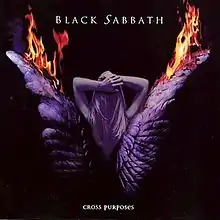Cross Purposes
Cross Purposes is the seventeenth studio album by English rock band Black Sabbath, released in January 1994.
| Cross Purposes | ||||
|---|---|---|---|---|
 | ||||
| Studio album by | ||||
| Released | 31 January 1994 | |||
| Recorded | 1993 | |||
| Studio | Monnow Valley Studios, Rockfield, Monmouthshire, Wales | |||
| Genre | Heavy metal | |||
| Length | 47:27 | |||
| Label | I.R.S. | |||
| Producer | Leif Mases, Black Sabbath | |||
| Black Sabbath chronology | ||||
| ||||
Album information
Dehumanizer saw the reunion of Mob Rules-era Black Sabbath, but, after the tour, Ronnie James Dio (vocals) and Vinny Appice (drums) departed. They were replaced by former Sabbath vocalist Tony Martin and former Rainbow drummer Bobby Rondinelli. Geezer Butler remained with the group, although he would depart later in the year again before the recording of the Forbidden album. Rondinelli left the recording sessions for Quiet Riot's album "Terrified" to join Black Sabbath.
The song "Cardinal Sin" was originally intended to be titled "Sin Cardinal Sin" (or "Sin, Cardinal Sin") but a printing error on the album sleeve caused the first word to be removed. Sabbath simply adopted the title "Cardinal Sin" as the name of the song.
A promo video in black-and-white was shot for the song "Hand That Rocks the Cradle". Tony Martin explains in an interview with Martin Popoff that he wrote this song about Beverly Allitt, a children's hospital nurse in England who was convicted of serial infanticide in 1993. The video features a young girl, assumably in reference to this.[1]
"What's the Use?" was released only on the Japanese edition of Cross Purposes, which also contained a free sticker of the artwork. A nearly identical version of the "burning angel" image was featured on a Scorpions single three years earlier.
Tony Martin explained during the show at Roseland in NYC on February 12, 1995 that "Psychophobia" was about David Koresh, and the Waco, Texas incident.[2]
The album was recorded at Monnow Valley Studio, in Wales.[3]
Critical reception
| Review scores | |
|---|---|
| Source | Rating |
| AllMusic | |
| Entertainment Weekly | D[5] |
| The Rolling Stone Album Guide | |
The album peaked at number 122 on the US Billboard 200 charts but made it to number 41 on the UK Billboard 200 charts.[7] In both Finland and Sweden, the album hit #9.
In July 2014, Guitar World magazine ranked Cross Purposes at number six in the "Superunknown: 50 Iconic Albums That Defined 1994" list.[8]
Track listing
All tracks are written by Geezer Butler, Tony Iommi and Tony Martin, except "Evil Eye" written by Butler, Iommi, Martin, and Eddie Van Halen (who was not credited, due to restrictions from his record label, Warner Bros. Records).
| No. | Title | Length |
|---|---|---|
| 1. | "I Witness" | 4:56 |
| 2. | "Cross of Thorns" | 4:32 |
| 3. | "Psychophobia" | 3:16 |
| 4. | "Virtual Death" | 5:49 |
| 5. | "Immaculate Deception" | 4:15 |
| 6. | "Dying for Love" | 5:53 |
| 7. | "Back to Eden" | 3:57 |
| 8. | "The Hand That Rocks the Cradle" | 4:31 |
| 9. | "Cardinal Sin" | 4:20 |
| 10. | "Evil Eye" | 5:58 |
| 11. | "What's the Use?" (Japanese Edition bonus track) | 3:03 |
Personnel
- Black Sabbath
- Tony Martin – vocals
- Tony Iommi – guitar
- Geezer Butler – bass
- Bobby Rondinelli – drums
- Geoff Nicholls – keyboards
- Production
- Leif Mases – producer, engineer, mixing
- Darren Galer – assistant engineer
- Dave Somers – assistant engineer
- Tony Cousins – mastering
Chart positions
| Year | Chart | Position |
|---|---|---|
| 1994 | Sweden | 9 |
| Austria | 23 | |
| Germany | 32 | |
| United Kingdom | 41 | |
| Switzerland | 41 | |
| Netherlands | 85 | |
| U.S. Billboard 200 | 122 | |
References
- Popoff, Martin (2011). Black Sabbath: Doom Let Loose: An Illustrated History. Da Capo Press.
- Live recording February 15, 1994 Youtube.
- Stolz, Nolan (2017). Experiencing Black Sabbath: A Listener’s Companion. Rowman & Littlefield. p. 173. ISBN 9781442256910.
- Bradley Torreano (8 February 1994). "Cross Purposes - Black Sabbath | Songs, Reviews, Credits, Awards". AllMusic. Retrieved 18 May 2014.
- Frost, Deborah (11 February 1994). "Cross Purposes Review". Entertainment Weekly. Retrieved 5 June 2012.
- "Black Sabbath: Album Guide". Rolling Stone. Archived from the original on 27 April 2012. Retrieved 5 June 2012.
- "Billboard album chart history-Black Sabbath". Retrieved 15 February 2009.
- "Superunknown: 50 Iconic Albums That Defined 1994". GuitarWorld.com. 14 July 2014. Archived from the original on 15 July 2014. Retrieved 14 July 2014.